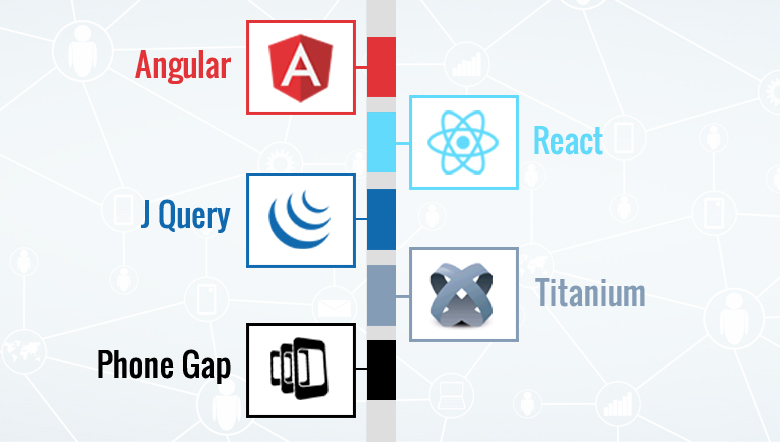Angular or React or JQuery or Titanium or PhoneGap: which is the best JavaScript framework in 2017? This is the hot topic that baffles the brain of web/mobile app developers and entrepreneurs alike. There are several JavaScript Frameworks available that a developer can take help to create engaging web/mobile apps. A developer can find a JavaScript Framework truly helpful in building an app with exceptional features. There are many Angular JS Development Company.
However, it is important to choose the right framework for a specific application development that can meet the requirements of a developer more precisely.
Here, we are presenting a list of popular JavaScript Frameworks, with their features and unique properties, helping developers to choose the best framework for their app development.
Want to hire Blockchain Developers at 60% less cost?
Table of Contents
1. AngularJS 4.0
After the most awaited official release of AngularJS 4.0, the popularity of the framework has reached a new level in today’s time. However, this is still a risky decision to jump to the new version if you are not so sure.
Whatever the conclusion you come to, you must admit that AngularJS (maintained by Google) has the capacity to build web applications like no other. With a rapid development pace, easy code integration, readiness for unit testing AngulatJS can certainly be your choice for the next project.
AngularJS Pros:
— Good documentation.
— As Angular supports caching and many other processes, it means the server performs extremely well.
— Rapid prototyping is indeed a buzzword thanks to the existence of frameworks like Angular
— Angular helps you to build responsive, fast-loading and seamlessly navigating websites and apps.
— It implements Model-View-View and Model-View-Controller model architectural patterns which lay strong foundations for application performance.
— It uses directives that keep HTMP pages and scripts mess-free and extremely organized.
— If you are a fast learner, you can get familiar with AngularJS in no time
— Two-way data binding simplifies some parts of the process.
AngularJS Cons:
— JavaScript support is mandatory. If JavaScript support is disabled, the associated users will not be able to access your web appsQuite layered and arranged hierarchically, scopes can be complex entities to handle if it is your first experience with Angular
— Quite layered and arranged hierarchically, scopes can be complex entities to handle if it is your first experience with Angular
— Difficulties with understanding the code and debugging.
— Substantial framework size.
Want to hire Mobile App Developer?
2. ReactJS
One of the other top JavaScript Frameworks in today’s time is ReactJS and again maintained by a reputed brand Facebook. Be its ability to perform well in SEO (surprisingly being part of JS family), Simpler JSX, Virtual DOM or powerful JavaScript library, ReactJS is a developer’s choice to build dynamic & high traffic web applications.
However, while comparing with AngularJS, ReactJS falls short in testing simplicity and component structure. Also, needless to say, this does not make ReactJS fall short from AngularJS.
ReactJS Pros:
— It is quite easy to be mastered.
— It is easy to maintain isolated components in React.
— Constant re-rendering of components provides efficient arranging at increasing complexity.
— Convenient architecture – Flux – is highly competitive to MVC. One-way data flow provides maintainability and efficient arrangement of data and DOM elements.
— It is the most light-weighted framework among the ones that are widely used today.
ReactJS Cons:
— Some issues with DOM manipulation libraries are possible (e.g., jQuery).
— Frequent re-rendering may slow down the work of application for handling a large set of data.
3. JQuery Mobile:
JQuery is a popular framework building mobile apps that can easily be accessed through a variety of devices, including touch-enabled devices. It is easy to integrate with third-party technologies and this expands its application area.
With HTML5 and CSS3, a developer can easily achieve a custom-made user interface for his/her mobile application. The latest version of JQuery features a lightweight code base, which helps optimize the speed.
JQuery Pros:
— Easy to develop, if you understand HTML(HTML5) you will have a pretty good understanding of jQuery Mobile
— Excellent 3rd party support, what through knowledge what through plugins
— Easy to debug
— Better for mobile web applications
— Official documentation
JQuery Cons:
— Sometimes slow and sluggish on mobile devices, the application needs to be designed properly
— Dull look unless you are capable UI designer. All applications look the same, and it looks pretty bad on large screens
— Official documentation is lacking in some segments, too few information about jQuery Mobile architecture and JavaScript
4. Appcelerator Titanium:
This open-source platform is more popular for developing cross-platform native apps. One can easily learn the framework to quickly build apps to be run on different platforms.
With a basic web development skill, one can build scalable apps, based on the MVC pattern. The framework allows developers to take better advantage of the native functionality of a device and include custom features.
Titanium Pros:
— By using native UI components, we achieve a distinct performance win;
— The Alloy framework works to normalize the UI across platforms;
— By using JavaScript, in normalizing code cross-platform, you can leverage existing skills on multiple platforms;
— Added value is realized being that Appcelerator provides items such as App Analytics and Backend-as-a-Service (BaaS);
— Titanium is free, as well as open-source.
Titanium Cons:
— Developers must manage platform SDKs locally; it’s recommended that you maintain a controlled build environment – a continuous integration (CI) process – particularly when targeting multiple platforms.
— SDK- related issues, due to versions and build, can rob time that is always better-suited to the delivery of product and features.
— The normalization of the UI across platforms, generally viewed as a Pro, can be a Con that requires the team to train on proprietary technology, and these skills are not applicable outside Titanium.
Get well-balanced, experienced and scalable hand-picked dedicated software development teams from PixelCrayon
5. PhoneGap
PhoneGap is essentially based on Cordova. Cordova/PhoneGap provides a set JavaScript APIs that connect to the device’s native functions such as Camera, Compass, Contacts, and Geolocation. Cordova/PhoneGap lets us build a mobile application without the native programming language; instead, we can use a framework like jQuery Mobile. It will compile your app using the platform’s SDK and will be ready to install on the platform it supports including iOS, Android, Windows Phone, Blackberry, and Web OS.
PhoneGap Pros:
— No need to learn other complicated languages to create mobile apps. All developers should know is JavaScript, HTML5, and CSS3.
— All the PhoneGap apps can be installed much like a native app, and are able to leverage app store discoverability.
— It follows a plug-in architecture, which indirectly means that access to the native device APIs can be extended in a modular way.
— Using PhoneGap would enable you to distribute and integrate payment through the app store.
— Leverage from tons of libraries.
PhoneGap Cons:
If your mobile app includes too many graphic elements, performance could be a big issue.






